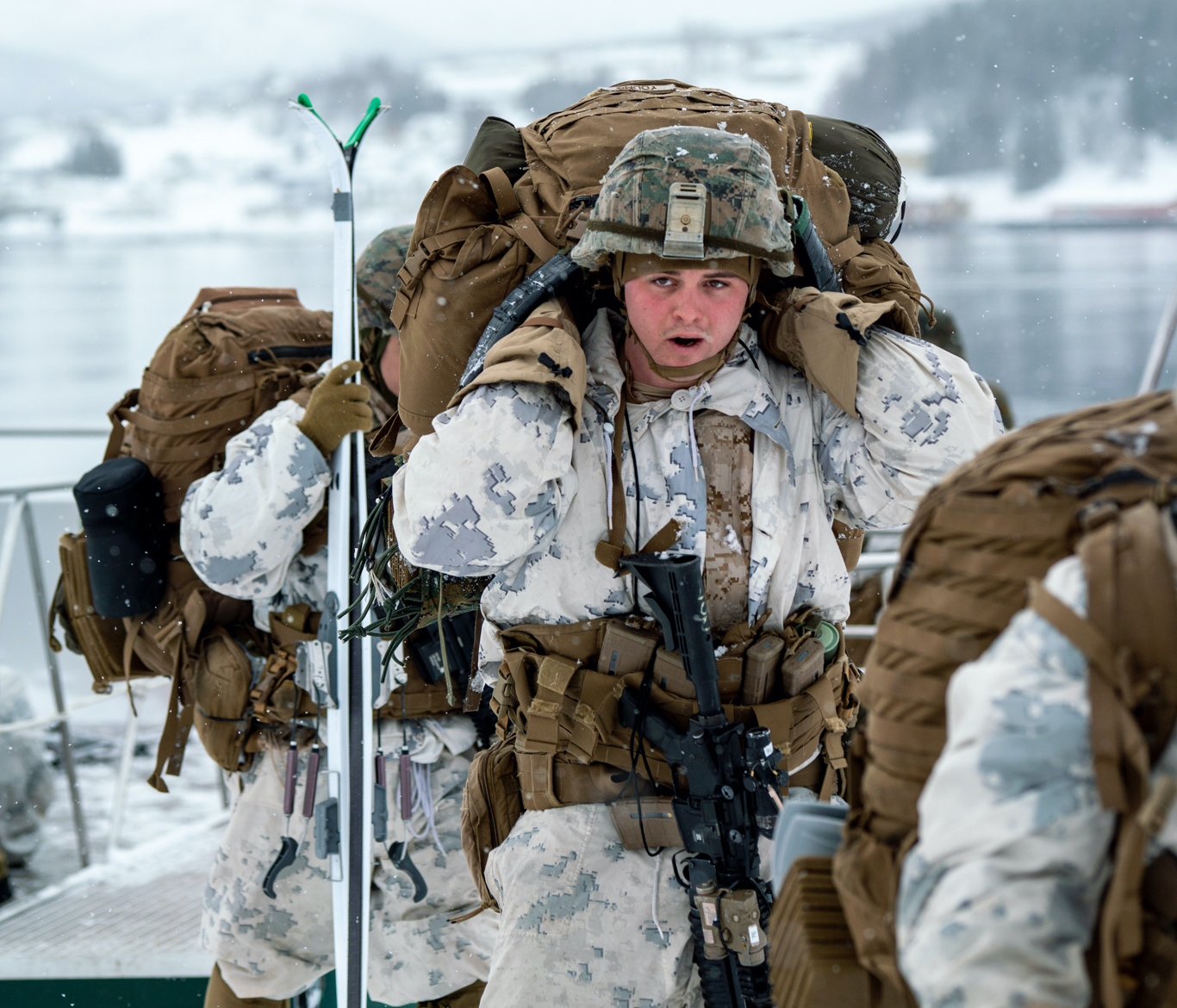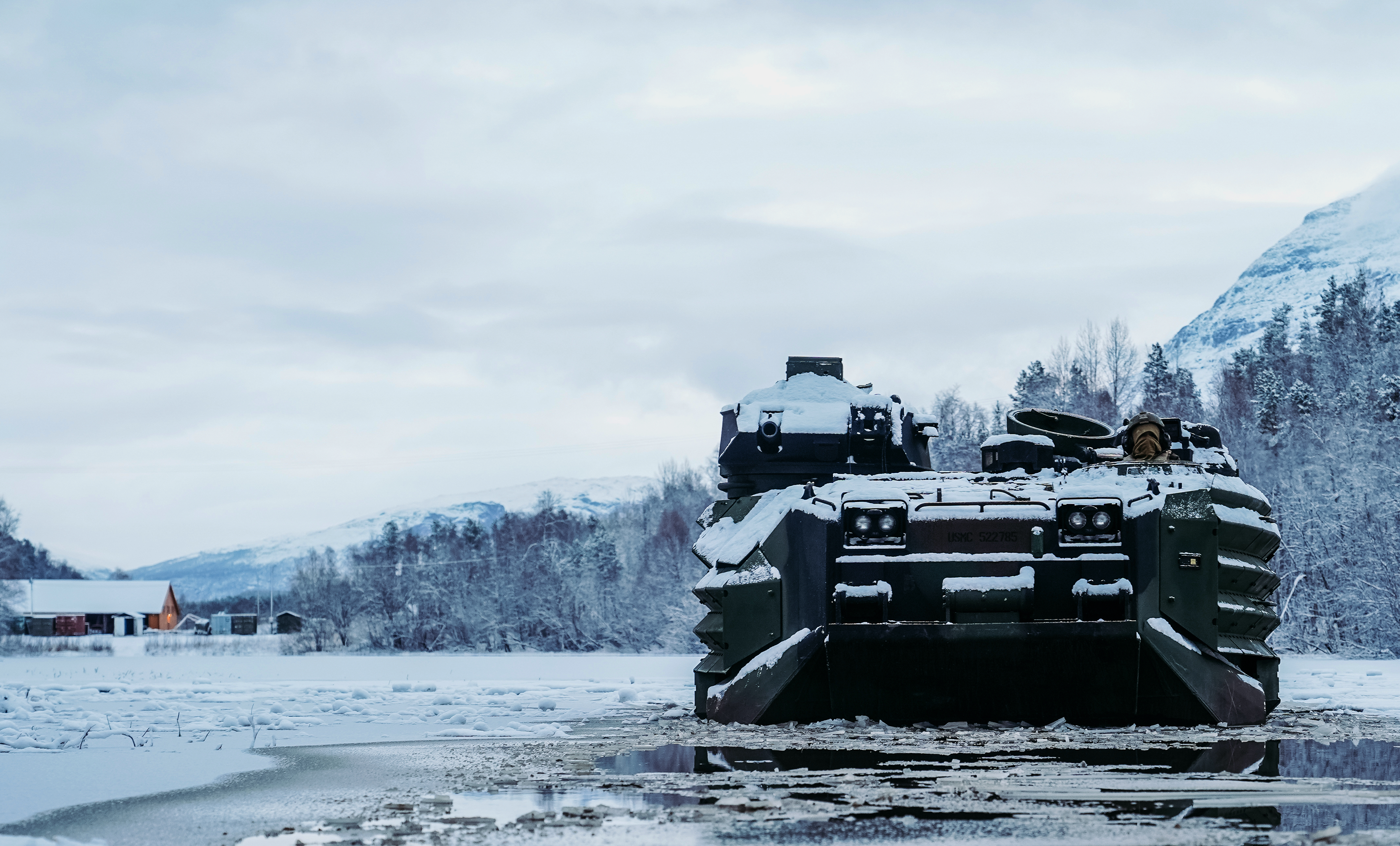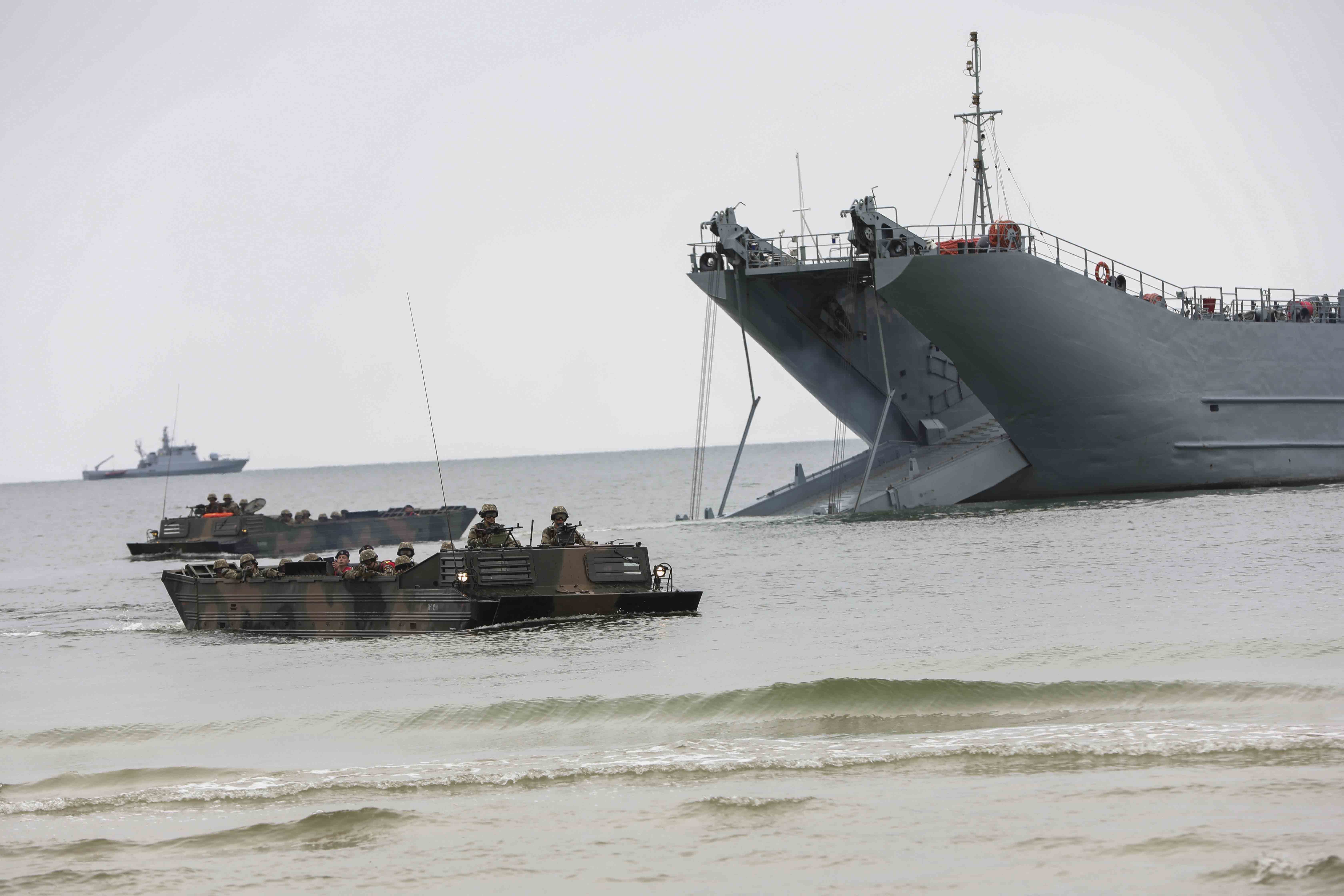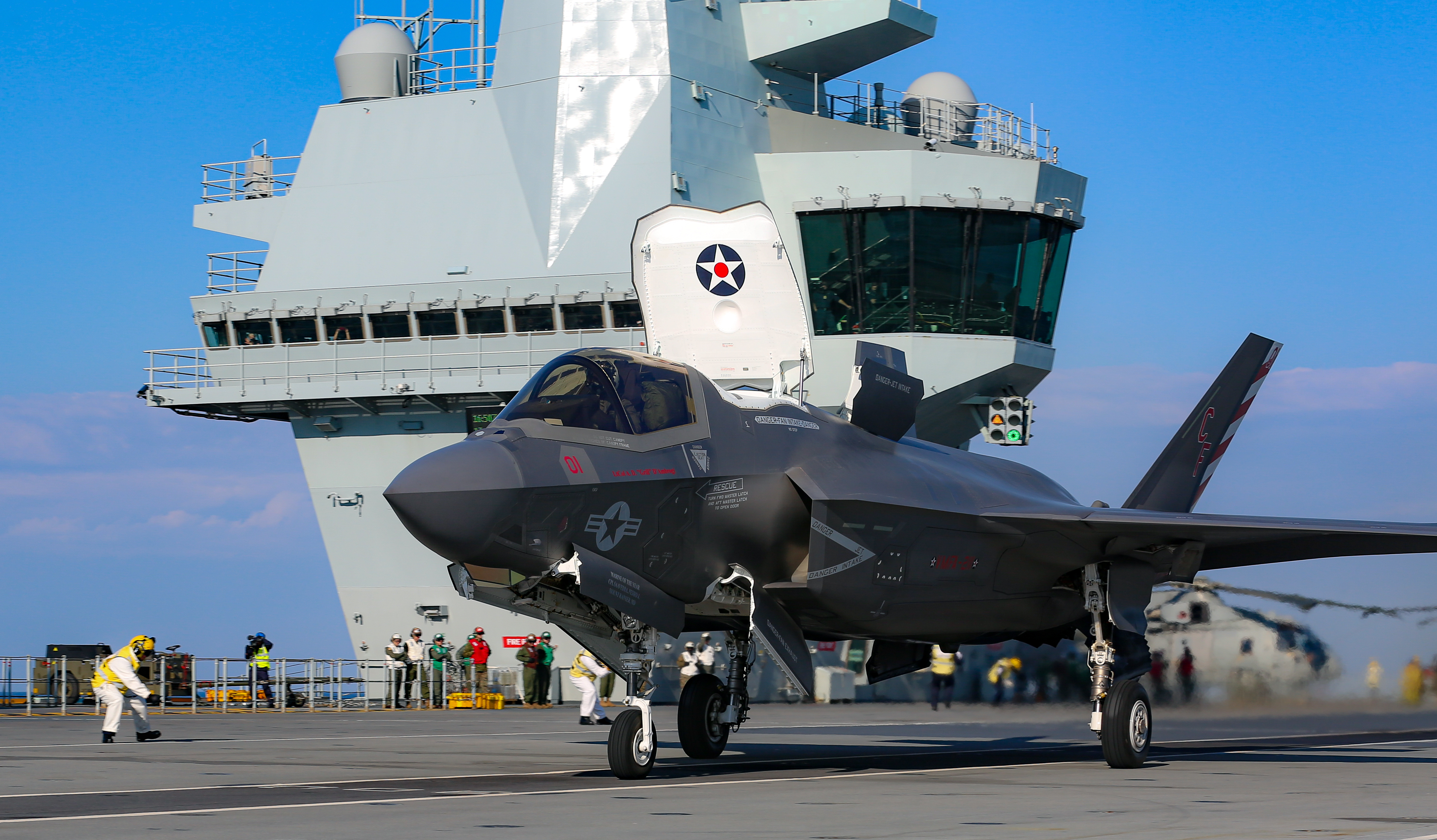
The head of NATO’s maritime force says amphibious operations will play a big role in any future combat or crisis response scenario – but he wants to move beyond old notions of what an amphibious operation really is.
Royal Navy Vice Adm. Keith Blount, commander of NATO’s Allied Maritime Command (MARCOM), said this week that amphibious operations often bring to mind images of the battle of Iwo Jima or the World War II movie “Saving Private Ryan.” But he highlighted three countries’ new amphibious concepts that are attractive options to him and make best use of emerging technologies like unmanned systems, cyber, electronic warfare, networks and more – and, coincidentally or not, don’t feature the word “amphibious” in their names.
Blount first highlighted the U.S. Marine Corps’ new naval expeditionary warfighting concept, Expeditionary Advanced Base Operations.
“I think is particularly attractive and interesting – and actually quite distinct in the way that it sets various forms of capability apart but nevertheless threads them together. It’s not a linear form of warfighting, it’s a very dispersed, nonlinear approach to warfighting to deliver to the adversary a number of different effects that range from simply influence right away to kinetic fires. And it uses within it a lot of terms that we would be familiar with, but the word ‘amphibious’ doesn’t really appear.”
Blount also highlighted “the United Kingdom’s own Littoral Strike idea and its Future Commando Force orientated around Littoral Strike Groups or Littoral Response groups that will be deployed dispersed in a persistent way, whether in support of NATO operations further east or south. It blends some traditional thinking around amphibiosity with fifth-gen firepower, which immediately draws the attention of the capability to the most modern form of warfighting that we have, capable of interdicting and ultimately dispatching anti-access and area-denial systems.”
And third, he mentioned the Netherlands’ new approach, which “talks about the three-landscape model: the human, the physical and the information landscapes.”
“It identifies key points that need to be penetrated or interdicted,” Blount said. Additionally, he said, it includes mobile cyber teams that can be an advance force and go deep into enemy territory to set up cyber networks, which Blount said is a niche capability today but could become the way of doing things in the future.

“I’m genuinely of the view that these new initiatives, branded in the way that they are … is the way in which we need to create an optic for the future use of amphibious power … to those who are in a position to write ultimately the checks,” Blount said, referring to individual countries’ chiefs of navy, who man, train and equip the navies that he can use as the NATO MARCOM commander.
Blount said during his remarks that a focus on command and control (C2) and networks in the littoral environment – where navies can project power from the sea to the shore seamlessly – is what he finds most useful about these models for considering future littoral warfare in places like the Mediterranean Sea, the Black Sea, the Baltic Sea or even the High North.
During the same event, U.S. Marine Corps Maj. Gen. Tracy King, who recently took over as the commander of U.S. Marine Corps Forces Europe and Africa, echoed similar themes. He discussed the Navy and Marines’ upcoming Light Amphibious Warship program, which he helped develop in his previous job as the director of expeditionary warfare on the chief of naval operations’ staff (OPNAV N95). He said LAW would help in supporting “that brown water C2 that the amphibious forces bring to a joint and combined force.
Additionally, he said, LAW will “enhance the tactical mobility of those units.”
“I’m firmly convinced that in 21st Century warfare it’s no longer going to be the big that eat the small; it’s going to be the fast that eat the slow,” he said, noting that anything to speed up decision-making, detecting and engaging targets, and moving rapidly from one place to another would be important to the Marines.
Though the U.S. joint force is investing heavily in joint networks for a future fight, King said the amphibious force also needs to be prepared to fight in a network-degraded environment. He said land forces are comfortable with mission control – they’re given specific tasks and also told the purpose, so they can adjust if needed and still meet the target objectives – but he said the Navy isn’t always comfortable operating that way.
“It becomes a force-multiplier that actually generates tempo,” he said of the mission command model, adding that speed and agility from the sea will be essential.
“The entire force, all the way down to the guy who’s driving that minesweeper, to the guy who’s flying that airplane all by himself, understands the reason why he’s doing what he’s doing, so that when the obvious chaos, the obvious fog and friction, the obvious fact that, you know what, Hill 101 doesn’t exist and you told me to take it – well, I understand why you wanted me to take it, so now I’m going to do something else to meet the purpose. That is mission command. Doing that in major exercises, I think, is very important.”
During the conference, Royal Marines Deputy Commandant-General and Deputy Director of Littoral Strike Brigadier Anthony Turner said the Royal Marines are looking at ways to be more agile too as part of their Future Commando Force modernization effort. As part of that, the Royal Marines have formed a new Vanguard Strike Company that will “trailblaze this new capability and procedures. We’ve provided these 150 Royal Marines with access to game-changing technology and weaponry as they head off on their first deployment. Using this company as a steppingstone, we will build and agile and adaptive force which is engaged, scalable and interoperable across the spectrum of conflict.”

Blount, as the NATO maritime force commander, leads an effort called the NATO Amphibious Leaders Expeditionary Symposium. NALES tested out the first iteration of its ideas for allied amphibious operations during the 2019 Baltic Operations (BALTOPS) exercise and continues its work on refining concepts and advocating for NATO members’ to invest in their amphibious forces, he said.
Blount said MARCOM has four standing naval forces that member countries contribute to and participate in on a rotational basis: Standing NATO Maritime Groups 1 and 2, which include surface combatants like frigates, and Standing NATO Mine Countermeasures Groups 1 and 2, which include counter-mine assets. Neither involve amphibs, and Blount said he’d like to see that change.
“The standing naval force and the way it is constituted with its four standing groups is of course valuable and proven, but it doesn’t consider amphibious forces, and in my view it should. I have roles for those ships in peacetime as much as in crisis, I’m confident, whether as deterrence or even as bases for things like operational experimentation,” he said. Though BALTOPS was a good change to practice the NALES-produced concepts on a large scale, Blount said more regular experimentation and exercising needed to take place on the amphibious and littoral warfare side, to refine the command and control models and ensure that new technologies and new threats were accounted for.
“As we go through our thinking and our planning and our wondering about what the future character of conflict is going to look like, if we were to find ourselves within it, it’s not hard to still be able to identify areas in which amphibious operations can deliver decisive effects,” which means those operations need to be rehearsed, he said.

For example, he said, some countries have invested in the fifth-generation F-35 Joint Strike Fighter, while others don’t want it or can’t afford it. Still, he said, “if you don’t want to buy the jets … you need to be able to take the information from it.”
He said NATO was “some distance from” having a “proper digitized network” that can operate at the speed of relevance, but he hoped to address that going forward.
During the Defence IQ conference, U.S. Marine Corps Assistant Deputy Commandant for Combat Development and Integration Maj. Gen. Kevin Iiams explained some of the investments the Marines are making to support EABO and more broadly as part of its Force Design 2030 effort.
The focus is the Marine Littoral Regiment, which will include a littoral combat team, a littoral anti-air battalion and a littoral logistics battalion – not too different in organization from the rest of the Marine Air-Ground Task Force, but with an emphasis on being light, quick and able to maneuver through organic aircraft and the LAW.
The MLR will be “our inside force, our blunt force, existing and persisting inside that threat [weapons engagement zone], competing and contesting the space today vice just having to fight in from a distance tomorrow. We see this force as being a low-signature force with high-end both ground and air sensors to catalogue and track targets, holding them and the threat at risk day to day, with a highly resilient C2 capability to stay connected for even a collaborative strike.”
The first MLR will come online in Fiscal Year 2022 – after taking the 3rd Marine Regiment in Hawaii and transitioning it to the new formation – and will reach initial operational capability in FY 2023, USNI News has previously reported. Iiams said the next two units to transition will be 12th Marines and 4th Marines, and they’ll come online in FY 2025 and 2027.
To support this new way of operation, Iiams said the Marines would invest in a 300-percent increase in rocket artillery capacity, along with anti-ship missiles that will “profoundly enhance our ability to support the fleet commander in both sea control and sea denial.” Organic precision fires, including loitering munitions that can be employed from the MLR or by long-range unmanned surface vessels, will support operations, as will Naval Strike Missiles launched by unmanned Joint Light Tactical Vehicles.
“The entire intent is to impose a vast, strategic cost to the adversary, even with tactical forces,” Iiams said.
“Bottom line, what we really see is a modernized, lighter, lethal, autonomous, more resilient force with low signatures that enables amphibious and expeditionary operations across the spectrum from competition to conflict – and actually, when done right, dissuades and deters and brings us right back to the competition phase.”





